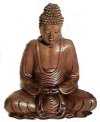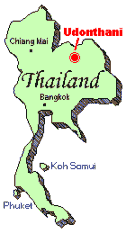

Seven steps to good case study use
"I don't know what to make of them," Stephen said to himself as he thought about the statues of Buddha he had seen in the homes of church elders.
"Are they idols, or are they simply symbols of national loyalty? In either case, do they not undermine the local Christians' allegiance to Christ? What should I do? Should I raise the issue in the annual meeting of the churches next week, or should I leave it up to the local leaders to decide? Do these relatively new believers fully understand the spiritual implications?"
Stephen Ling, an American of Chinese ancestry, had come as a missionary to Nong Pai in northeastern Thailand to minister to the developing Thai Christian community there. With a theological degree and training in evangelism and discipleship in his background, he was excited about his new assignment. He had worked hard on learning the local language and culture and had begun feeling at home in Thailand.
The work had been started years earlier by American missionaries Jerry and Sue Lannin. It had now grown to 550 believers in 49 congregations that met in local homes. Each church was composed of two to twelve families and led by an "elder." Staff at an administrative center in the provincial capital of Udonthani coordinated the work of the churches and evangelistic outreach efforts.
When the Lannins retired, they asked Stephen to take charge of their work. One of his chief tasks was training the "elders" or local church leaders. Each week, he visited several of them in their village homes to help them prepare for the services they conducted in their homes on Sundays.
One of Stephen's first visits had been to the home of Seum, the young church leader in Nong Pai. Seum ran a general store and lived in rooms attached to the rear of the store. Worship services were held in his living room.
In the entry were two rows of pictures. On top were photographs of the military graduation class of one of his family members, the queen of Thailand, the king, and the crown prince, a collective picture of the head monks of a Thai monastic order and Thai military officers, plus a military recruiting poster. What had been even more startling to Stephen than monks' photos was that the second row held magazine and calendar pinups of Thai girls in bathing suits. On the far right was a statue of the Buddha.
In visits to other elders' homes, Stephen found that the photo/statue display was typical of village homes, including those of Christians. In the minds of the people in that part of Thailand, there was a close tie between Thai nationalism, the royal family, the military, and Buddhism.
At first, Stephen had hoped that the weekly Bible teaching would lead the Christians to get rid of their Buddha statues. That hadn't happened. To new Thai believers, displaying a Buddha statue seemed to be an act of patriotism as well as an expression of political loyalty to the king. History also played an important part in the issue. The northeastern part of Thailand had a long record of political and military instability caused in part by invasions of foreign powers. Because of that, people wanted to affirm their allegiance to a government that had brought them peace and a sense of security.
Four months later, Stephen made a second visit to Nong Pai to meet with Seum and several other elders. He decided to ask why they kept their Buddha pedestals. In response, Seum said that neither he nor his family performed rituals at the Buddha shrine, hoping to gain merit. "But," he said, "I am a Thai and a loyal subject of our king. So, I keep the Buddha pedestal to show solidarity with my neighbors, my town, and my country."
Wassana, a senior elder, defended Seum's position by appealing to Paul's doctrine of Christian liberty found in Galatians and to his discussion of eating meat offered to idols in his letter to the Corinthians.
Back home, Stephen questioned the decision of the church leaders. While these leaders usually looked to him for biblical and theological instruction, in this particular matter, they seemed sure of themselves. He wondered whether such an important decision should be left solely in their hands.
One of Stephen's friends back in the U.S. had several Asian friends. So, Stephen had written Danny for some advice. Danny wrote back: "I know many Chinese Americans who are Christians and yet still have Buddha statues in their homes. Some even burn incense in front of them. However, they say they do not worship the statue. They contend that what it represents -- peace, love, prosperity, and serenity -- are all attributes of Christ. But I say only Christ died for our sins. No Buddha did that. So, why don't they have a statue of Christ instead of Buddha?"
With the annual meeting of his churches coming up in a week, Stephen wondered if the confrontational strategy Danny had suggested would be the best course of action. Or, should he, as an expatriate missionary, let the matter lie and trust the Holy Spirit, since he did not want the Christians to be accused of disloyalty to their country. At the same time, he suspected that non-Christians would consider a person Buddhist if he or she displayed a Buddha statue. In addition, he was concerned that in the long run, it would open the door to syncretism. Finally, after considerable prayer and study of the Scripture, Stephen decided to....

This case study is an edited version of one by Lee-Lim Guek Eng that appeared in Case Studies in Missions, edited by Paul and Frances Hiebert, Baker Book House. It may be reproduced only by paying a 35-cent per copy royalty to Baker Book House, PO Box 6787, Grand Rapids, MI 49516 USA
One possible explanation: How would you react to it? |
| Here's one Buddhist's explanation of what was going on. How would you talk with someone who came up with this explanation? Would this explanation be something that should be discussed with the church elders?
"What those men were portraying by having a Buddha with posters around it on the wall (even though they are now Christians) were simply their astral levels. "Of course, we all worship the Creator God at our highest level (represented by the Buddha as peace, love, joy, and prosperity -- all attributes of the true God). Another level is national loyalty (represented by a photo of the leader of Thailand). Lower down those men's astral levels are things symbolized by the pretty girls (indicating a level where they have lust or lasciviousness). "When one dies, he can either live at a lower level of his interests or astral levels (even the one where he lusts after women), or he can go to the highest level (represented by the Buddha statue where he has only peace and godly love). "This can be shown by the fact that at some level of reality, a car mechanic is just a car mechanic if he was trained as that. However, he also may have lust within him for women -- that's another level of that car mechanic." |
-- Howard Culbertson, hculbert@snu.edu
A Buddha statue is a physical representation of the Buddha, Siddhartha Gautama, who lived in ancient India and founded Buddhism. These statues hold deep symbolic significance in Buddhist tradition and practice. They serve at least four purposes:
For many people, a Buddha statue embodies the essence of Buddhist philosophy since it serves as a tangible representation of the ideals of enlightenment, compassion, and spiritual awakening. The statues thus become a focal point for devotion. Buddhists feel that, in some way, those statues offer guidance as well as inspiration.